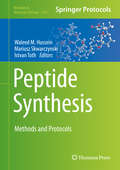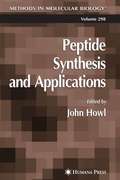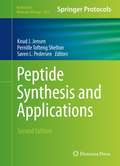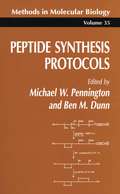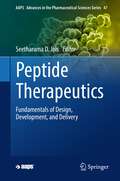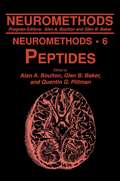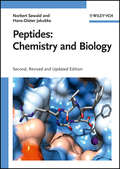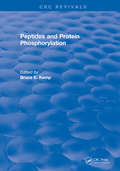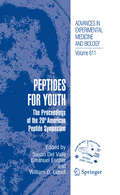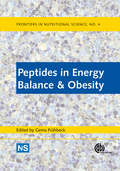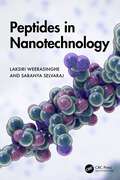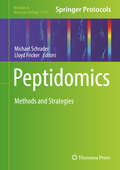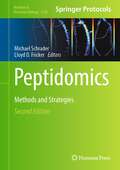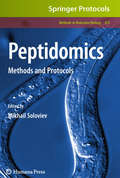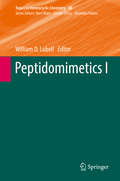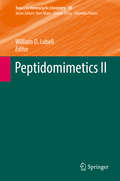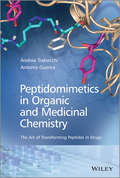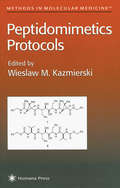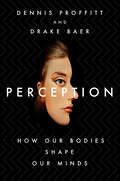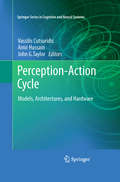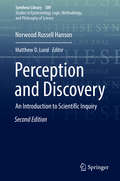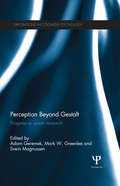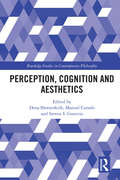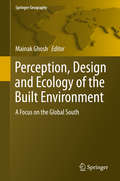- Table View
- List View
Peptide Synthesis: Methods and Protocols (Methods in Molecular Biology #2103)
by Waleed M. Hussein Mariusz Skwarczynski Istvan TothThis book provides a variety of procedures for synthetically producing peptides and their derivatives, ensuring the kind of precision that is of paramount importance for successful synthesis. Numerous techniques relevant to drugs and vaccines are explored, such as conjugation and condensation methodologies. Written for the highly successful Methods in Molecular Biology series, chapters include introductions to their respective topics, lists of the necessary materials and reagents, step-by-step, readily reproducible laboratory protocols, and tips on troubleshooting and avoiding known pitfalls. Authoritative and practical, Peptide Synthesis: Methods and Protocols serves as an essential guide to the many crucial processes that will allow researchers to efficiently prepare, purify, characterize, and use peptides for chemical, biochemical, and biological studies.
Peptide Synthesis and Applications
by John HowlHands-on experts describe in step-by-step detail the key methodologies of contemporary peptide synthesis and illustrate their numerous applications. The techniques presented include protocols for chemical ligation, the synthesis of cyclic and phosphotyrosine-containing peptides, lipoamino acid- and sugar-conjugated peptides, and peptide purification and analyses. Additional chapters detail methodologies and instrumentation for high-throughput peptide synthesis, many different applications of peptides as novel research tools and biological probes, and the design and application of fluorescent substrate-based peptides that can be used to determine the selectivity and activity of peptidases. A practical guide to the identification of proteins using mass spectrometric analyses of peptide mixtures is also included.
Peptide Synthesis and Applications
by Soren L. Pedersen A. Pernille Tofteng Knud J. JensenPeptides are used ubiquitously for studies in biology, biochemistry, chemical biology, peptide based medicinal chemistry, and many other areas of research. There is a number of marketed peptide drugs, and the prospects for the development of new peptide drugs are very encouraging. The second edition of Peptide Synthesis and Applications expands upon the previous editions with current, detailed methodologies for peptide synthesis. With new chapters on laboratory protocols for both the specialist and the non-specialist. Written in the highly successful Methods in Molecular Biology series format, chapters include introductions to their respective topics, lists of the necessary materials and reagents, step-by-step, readily reproducible laboratory protocols, and key tips on troubleshooting and avoiding known pitfalls. Authoritative and practical, Peptide Synthesis and Application, Second Edition seeks to aid scientists in understanding different approaches to the synthesis of peptides by using a broad range of methods and strategies.
Peptide Synthesis Protocols
by Ben M. Dunn Michael W. PenningtonIn Peptide Synthesis Protocols leading authorities assemble in one volume a broad range of state-of-the-art methods for the preparation, purification, and synthesis of peptides. These powerful and useful protocols contain many innovations not previously described, including a compilation of chemical modification procedures and peptide synthesis improvements. The authors describe each procedure in a practical, step-by-step fashion suitable for both the skilled and novice researcher. They also provide troubleshooting tips, alternative ways of doing things, and informative explanations about why certain steps are necessary--aids not usually found in standard journal recipes--all designed to guarantee a significant difference in the outcome of your experiments. Pennington and Dunn's Peptide Synthesis Protocols offers a comprehensive collection of standardized, readily reproducible methods for many critical procedures that will enable scientists in every area of biochemical and biological research to prepare, purify, characterize, and use peptides effectively.
Peptide Therapeutics: Fundamentals of Design, Development, and Delivery (AAPS Advances in the Pharmaceutical Sciences Series #47)
by Seetharama D. JoisThis book explains how peptide-based drug design works, what steps are needed to develop a peptide-based therapeutic, and challenges in synthesis as well as regulatory issues. It covers the design concept of peptide therapeutics from fundamental principles using structural biology and computational approaches. The chapters are arranged in a linear fashion. A fresh graduate or a scientist who works on small molecules can use this to follow the design and development of peptide therapeutics to use as understanding the basic concepts. Each chapter is written by experts from academia as well as industry. Rather than covering extensive literature, the book provides concepts of design, synthesis, delivery, as well as regulatory affairs and manufacturing of peptides in a systematic way with examples in each case. The book can be used as a reference for a pharmaceutical or biomedical scientist or graduate student who wants to pursue their career in peptide therapeutics. Some chapters will be written as a combination of basic principles and protocol so that scientists can adopt these methods to their research work. The examples provided can be used to perform peptide formulation considerations for the designed peptides. The book has nine chapters, and each chapter can be read as an independent unit on a particular concept.
Peptides (Neuromethods #6)
by Glen B. Baker Q. J. Pittman Alan A. BoultonThis timely new volume in Bouton and Bader's highly practical Neuromethods series presents state-of-the-art techniques for neuropeptide research. Neuromethods * 6 * Peptides highlights the vast array of novel techniques that are essential for identifying neural peptides and explaining their roles, which have become a significant focus of attention in neuropharmacology today. In addition to providing a detailed methodological formula for each technique, the authors - all renowned experts in their particular areas - also demonstrate how their powerful new methodologies contribute to our understanding of neuropeptide function. Chapters explore: * posttranslational processing, * radioimmunoassay development, * in vitro peptide release, * peptide analogs, * molluscan models, * anitbody production, * immunohistochemical localization, * peptide release in vivo, * postsynaptic sequences, * electrophysiological techniques
Peptides: Chemistry and Biology (Specialist Periodical Reports #Volume 44)
by Norbert Sewald Hans-Dieter JakubkeThoroughly updated, incorporating around 25 % new material, Sewald/Jakubke remains the only modern and scientifically up-to-date advanced textbook on peptide biochemistry, distilling the knowledge of hundreds of publications into a highly readable synopsis of this diverse field. The authors explain the broad fundamentals of peptide synthesis and structure, systematically addressing important families of biologically active peptides, and adopting an interdisciplinary approach that covers application areas in biotechnology, pharmaceutical science, and biomedicine. One major focus is on such "hot" research topics as pseudopeptides, peptidomimetics, and combinatorial synthesis. This new edition also features study questions for each learning unit, for easier self-study and classroom teaching.
Peptides and Protein Phosphorylation
by B.E. KempThis comprehensive volume focuses on the ways in which synthetic peptides have been exploited in order to expand our understanding of the molecular mechanisms involved in protein phosphorylation. It recognizes that virtually all physiological processes are regulated by protein phosphorylation. It discusses the use of synthetic peptides in studying the catalytic mechanism and regulation of protein kinases. It also includes the chemical synthesis of phosphorylated peptides and preparation of specific antisera. This incredible work has lead to the development of a new generation of peptide inhibitors with potencies of greater magnitude than those previously known. Everyone involved with biochemistry and molecular biology will find this one-of-a-kind resource fascinating and filled with useful information.
Peptides for Youth
by William D. Lubell Susan Valle Emanuel EscherThe American Peptide Society (APS) provides a forum for advancing and promoting knowledge of the chemistry and biology of peptides. The approximately one thousand members of the Society come from North America and from more than thirty other countries throughout the world. Establishment of the APS was a result of the rapid worldwide growth that has occurred in peptide-related research, and of the increasing interaction of peptide scientists with virtually all fields of science. Peptides for Youth: The Proceedings of the the 20th American Peptide Symposium will highlight many of the recent developments in peptide science, with a particular emphasis on how these advances are being applied to basic problems in biology and medicine. The 20th American Peptide Symposium will take place June 26 - 30, 2007 in Montreal, Canada.
Peptides in Energy Balance and Obesity
by Gema FrühbeckObesity is one of the most relevant public health concerns today and it is now evident that body weight control is achieved through highly integrated physiological interactions like nutrient selection as well as being influenced by genetic and environmental factors. Moreover, energy balance regulation is a complex process aimed at maintaining constant energy stores. Presenting a detailed and comprehensive account of the roles of specific peptides in energy balance, food intake control and co-morbidities, this review provides a better understanding of the patho-physiology of energy balance and obesity.
Peptides in Nanotechnology
by Laksiri Weerasinghe Saranya SelvarajAmong the various nanomaterials, peptides have emerged as a promising tool due to their unique properties such as high specificity, biocompatibility, and low toxicity. This book provides a comprehensive overview of the field of peptide-based nanomaterials, from their synthesis to their applications. It covers the latest advancements in peptide nanotechnology and provides detailed insights into various aspects of peptide-based nanomaterials, including their properties, synthesis, characterization, and potential applications in various biomedical fields.Features: Provides up-to-date detailed descriptions of various peptide-based nanostructures and their formation. Covers a wide range of topics related to peptides in nanotechnology including their synthesis and characterization. Includes the latest research and developments in the field of peptides in nanotechnology. Contains recent applications in drug delivery, tissue engineering, imaging and diagnostics, and targeted cancer therapy. Reviews peptide-nanoparticle conjugates (PNCs). This book is aimed at graduate students and researchers in peptide synthesis, biomedical engineering, and drug development and delivery.
Peptidomics: Methods And Strategies (Methods In Molecular Biology #1719)
by Lloyd Fricker Michael SchraderThis volume describes protocols for basic state-of-the-art approaches in the field of peptidomics. Most of these approaches are independent of the instruments used for analysis and can easily be adapted for equipment that is available in a typical proteomics facility. Chapters detail many of the basic techniques used to detect and identify peptides, methods for the relative quantitation of peptides between samples using isotopic labels or label-free approaches, and biological species as well as sample types. Written in the highly successful format of the Methods in Molecular Biology series, each chapter includes an introduction to the topic, a list of the necessary materials and reagents, reproducible step-by-step laboratory protocols, and tips on troubleshooting common problems and avoiding pitfalls.Authoritative and practical, Peptidomics: Methods and Strategies provides useful guidance for studies in the rapidly growing field of peptidomics.
Peptidomics: Methods and Strategies (Methods in Molecular Biology #2758)
by Michael Schrader Lloyd D. FrickerThis updated edition explores essential techniques and newly emerged applications used in the expanding field of peptidomics. The opening chapters describe sample preparation and basic techniques. Subsequent chapters delve into quantitative peptidomics, bioinformatics, deep learning approaches, non-human model organisms, and peptide toxins. The last section includes multiple chapters on applications of peptidomics for human clinical specimens. Written for the highly successful Methods in Molecular Biology series, chapters include overviews and introductions to their respective topics, lists of the necessary materials, reagents, and instrumentation, step-by-step and readily reproducible laboratory protocols, and tips on troubleshooting and avoiding known pitfalls. Authoritative and up-to-date, Peptidomics: Methods and Strategies, Second Edition serves as an ideal guide for state-of-the-art approaches in this vital field.
Peptidomics
by Mikhail SolovievDespite being known and studied for years, peptides have never before attracted enough attention to necessitate the invention of the term "peptidomics" in order to specify the study of the complement of peptides from a cell, organelle, tissue or organism. In Peptidomics: Methods and Protocols, expert researchers present a comprehensive range of analytical techniques for the analysis of the peptide contents of complex biological samples with an emphasis often on higher throughput techniques, suitable for the analysis of large numbers of peptides typically present in the peptidomes. Encompassing a number of species ranging from bacteria to man, the methods presented intensively cover topics such as organism handling, tissue and organ dissection, cellular and subcellular fractionation, peptide extraction, fractionation and purification, structural characterization, molecular cloning, and sequence analysis. Written in the highly successful Methods in Molecular BiologyTM series format, chapters include introductions to their respective topics, lists of the necessary materials and reagents, step-by-step, readily reproducible laboratory protocols, and notes on troubleshooting and avoiding known pitfalls. Comprehensive and cutting-edge, Peptidomics: Methods and Protocols brings this ten year old field fully up-to-date in order to inspire novices and experts alike with the easy-to-follow practical advice needed to set up and carry out analysis of the peptide contents of complex biological samples.
Peptidomimetics I
by William D. LubellThe series Topics in Heterocyclic Chemistry presents critical reviews on present and future trends in the research of heterocyclic compounds. Overall the scope is to cover topics dealing with all areas within heterocyclic chemistry, both experimental and theoretical, of interest to the general heterocyclic chemistry community. The series consists of topic related volumes edited by renowned editors with contributions of experts in the field. All chapters from Topics in Heterocyclic Chemistry are published Online First with an individual DOI. In references, Topics in Heterocyclic Chemistry is abbreviated as Top Heterocycl Chem and cited as a journal.
Peptidomimetics II
by William LubellThe series Topics in Heterocyclic Chemistry presents critical reviews on present and future trends in the research of heterocyclic compounds. Overall the scope is to cover topics dealing with all areas within heterocyclic chemistry, both experimental and theoretical, of interest to the general heterocyclic chemistry community. The series consists of topic related volumes edited by renowned editors with contributions of experts in the field. All chapters from Topics in Heterocyclic Chemistry are published Online First with an individual DOI. In references, Topics in Heterocyclic Chemistry is abbreviated as Top Heterocycl Chem and cited as a journal.
Peptidomimetics in Organic and Medicinal Chemistry
by Andrea Trabocchi Antonio GuarnaA peptidomimetic is a small protein-like chain designed to mimic a peptide with adjusted molecular properties such as enhanced stability or biological activity. It is a very powerful approach for the generation of small-molecule-based drugs as enzyme inhibitors or receptor ligands.Peptidomimetics in Organic and Medicinal Chemistry outlines the concepts and synthetic strategies underlying the building of bioactive compounds of a peptidomimetic nature. Topics covered include the chemistry of unnatural amino acids, peptide- and scaffold-based peptidomimetics, amino acid-side chain isosteres, backbone isosteres, dipeptide isosteres, beta-turn peptidomimetics, proline-mimetics as turn inducers, cyclic scaffolds, amino acid surrogates, and scaffolds for combinatorial chemistry of peptidomimetics. Case studies in the hit-to-lead process, such as the development of integrin ligands and thrombin inhibitors, illustrate the successful application of peptidomimetics in drug discovery.
Peptidomimetics Protocols
by Wieslaw M. KazmierskiA state-of-the-art collection of detailed synthetic procedures that lead to a variety of scaffolds, turn mimetics, peptide-bound replacements, and enzyme inhibitors. Topics range from unusual syntheses of amino acids to the use of a variety of linear and heterocyclic scaffolds in place of the peptide backbone. Important chemical procedures and methods include the transient protection of charged peptides as neutral prodrugs for improved blood-brain penetration and the replacement of peptide bonds with heterocyclic rings, olefins and fluoroolefins, and ketomethylenes. Synthetic protocols towards the transition-state mimics and reactive "warheads," applicable in enzyme inhibitors, are also disclosed.
Pequeños robots malvados
by Damien LoveMagia, robots y peligro... ¿qué puede salir mal? Un día de invierno, Alex recibe un misterioso regalo de su abuelo: un pequeño robot con una nota que dice "este es especial". Extraños sucesos comienzan a tener lugar, y Alex sospecha que su nuevo robot, más que especial, puede ser... ¿mortal? Damien Love vive en la ciudad de Glasgow, donde probablemente llueva mientras lees estas palabras. Ha trabajado como periodista durante muchos años, escribiendo sobre películas, música, televisión y otras cosas para una variedad de publicaciones, entre las cuales destacan The Sunday Herald, The Guardian y The Scotsman. Tiene la capacidad de hablar con los gatos, pero no hay evidencia de que lo entiendan. Pequeños robots malvados es su primera novela, un fascinante despliegue de imaginación y acción que te tendrá pegado a sus páginas.
Perception: How Our Bodies Shape Our Minds
by Dennis Proffitt Drake BaerA groundbreaking popular psychology book that explores the deep connection between our body and our brain.Over decades of study, University of Virginia psychologist Dennis Proffitt has shown that we are each living our own personal version of Gulliver’s Travels, where the size and shape of the things we see are scaled to the size of our bodies, and our ability to interact with them. Stairs look less steep as dieters lose weight, baseballs grow bigger the better players hit, hills look less daunting if you’re standing next to a close friend, and learning happens faster when you can talk with your hands.Written with journalist Drake Baer, Perception marries academic rigor with mainstream accessibility. The research presented and the personalities profiled will show what it means to not only have, but be, your unique human body. The positive ramifications of viewing ourselves from this embodied perspective include greater athletic, academic, and professional achievement, more nourishing relationships, and greater personal well-being. The better we can understand what our bodies are—what they excel at, what they need, what they must avoid—the better we can live our lives.
Perception-Action Cycle
by John G. Taylor Vassilis Cutsuridis Amir HussainThe perception-action cycle is the circular flow of information that takes place between the organism and its environment in the course of a sensory-guided sequence of behaviour towards a goal. Each action causes changes in the environment that are analyzed bottom-up through the perceptual hierarchy and lead to the processing of further action, top-down through the executive hierarchy, toward motor effectors. These actions cause new changes that are analyzed and lead to new action, and so the cycle continues. The Perception-action cycle: Models, architectures and hardware book provides focused and easily accessible reviews of various aspects of the perception-action cycle. It is an unparalleled resource of information that will be an invaluable companion to anyone in constructing and developing models, algorithms and hardware implementations of autonomous machines empowered with cognitive capabilities. The book is divided into three main parts. In the first part, leading computational neuroscientists present brain-inspired models of perception, attention, cognitive control, decision making, conflict resolution and monitoring, knowledge representation and reasoning, learning and memory, planning and action, and consciousness grounded on experimental data. In the second part, architectures, algorithms, and systems with cognitive capabilities and minimal guidance from the brain, are discussed. These architectures, algorithms, and systems are inspired from the areas of cognitive science, computer vision, robotics, information theory, machine learning, computer agents and artificial intelligence. In the third part, the analysis, design and implementation of hardware systems with robust cognitive abilities from the areas of mechatronics, sensing technology, sensor fusion, smart sensor networks, control rules, controllability, stability, model/knowledge representation, and reasoning are discussed.
Perception and Discovery: An Introduction to Scientific Inquiry (Synthese Library #389)
by Norwood Russell HansonMatthew D. LundNorwood Russell Hanson was one of the most important philosophers of science of the post-war period. Hanson brought Wittgensteinian ordinary language philosophy to bear on the concepts of science, and his treatments of observation, discovery, and the theory-ladenness of scientific facts remain central to the philosophy of science. Additionally, Hanson was one of philosophy’s great personalities, and his sense of humor and charm come through fully in the pages of Perception and Discovery.Perception and Discovery, originally published in 1969, is Hanson’s posthumous textbook in philosophy of science. The book focuses on the indispensable role philosophy plays in scientific thinking. Perception and Discovery features Hanson’s most complete and mature account of theory-laden observation, a discussion of conceptual and logical boundaries, and a detailed treatment of the epistemological features of scientific research and scientific reasoning. This book is of interest to scholars of philosophy of science, particularly those concerned with Hanson’s thought and the development of the discipline in the middle of the 20th century. However, even fifty years after Hanson’s early death, Perception and Discovery still has a great deal to offer all readers interested in science.
Perception Beyond Gestalt: Progress in vision research (Explorations in Cognitive Psychology)
by Adam Geremek Mark W. Greenlee Svein MagnussenHow does the brain piece together the information required to achieve object recognition, figure-ground segmentation, object completion in cases of partial occlusion and related perceptual phenomena? This book focuses on principles of Gestalt psychology and the key issues which surround them, providing an up-to-date survey of the most interesting and highly debated topics in visual neuroscience, perception and object recognition. The volume is divided into three main parts: Gestalt and perceptual organisation, attention aftereffects and illusions, and color vision and art perception. Themes covered in the book include: - a historical review of Gestalt theory and its relevance in modern-day neuroscience- the relationship between perceptive and receptive fields- a critical analysis of spatiotemporal unity of perception- the role of Gestalt principles in perceptual organization- self-organizing properties of the visual field- the role of attention and perceptual grouping in forming non-retinotopic representations- figural distortions following adaptation to spatial patterns- illusory changes of brightness in spatial patterns- the function of motion illusions as a tool to study Gestalt principles in vision- conflicting theories of color vision and the neural basis of it- the role of color in figure-ground segmentation- chromatic assimilation in visual art and perception- the phenomena of colored shadows.Including contributions from experts in the field, this book will provide an essential overview of current research and theory on visual perception and Gestalt. It will be key reading for researchers and academics in the field of visual perception and neuroscience.
Perception, Cognition and Aesthetics (Routledge Studies in Contemporary Philosophy)
by Dena Shottenkirk Manuel Curado Steven S. GouveiaThis volume addresses key questions related to how content in thought is derived from perceptual experience. It includes chapters that focus on single issues on perception and cognition, as well as others that relate these issues to an important social construct that involves both perceptual experience and cognitive activities: aesthetics. While the volume includes many diverse views, several prominent themes unite the individual essays: a challenge to the notion of the discreet, and non-temporal, unit of perception, a challenge to the traditional divide between perception and cognition, and a challenge to the traditional divide between unconscious and conscious intentionality. Additionally, the chapters discuss the content of perceptual experience, the value of traditional notions of content, disjunctivism, adverbialism, and phenomenal experience. The final section of essays dealing with perception and cognition in aesthetics features work in experimental aesthetics and unique perspectives from artists and gallerists working outside of philosophy. Perception, Cognition and Aesthetics is a timely volume that offers a range of unique perspectives on debates in philosophy of mind surrounding perception and cognition. It will also appeal to scholars working in aesthetics and art theory who are interested in the ways these debates influence our understanding of art.
Perception, Design and Ecology of the Built Environment: A Focus on the Global South (Springer Geography)
by Mainak GhoshThis edited volume is a compilation of the ‘built environment’ in response to many investigations, analyses and sometimes mere observations of the various dialogues and interactions of the built, in context to its ecology, perception and design. The chapters concentrate on various independent issues, integrated as a holistic approach, both in terms of theoretical perspectives and practical approaches, predominantly focusing on the Global South. The book builds fabric knitting into the generic understanding of environment, perception and design encompassing ‘different’ attitudes and inspirations. This book is an important reference to topics concerning urbanism, urban developments and physical growth, and highlights new methodologies and practices. The book presumes an understanding unearthed from various dimensions and again woven back to a common theme, which emerges as the reader reads through.Various international experts of the respective fields working on the Global South contributed their latest research and insights to the different parts of the book. This trans-disciplinary volume appeals to scientists, students and professionals in the fields of architecture, geography, planning, environmental sciences and many more.
